Adaptive robotic assistance of the upper limb based on biomechanical and physiological response of the human
DOI:
https://doi.org/10.29057/icbi.v10iEspecial5.10205Keywords:
Force Feedback, Human Performance, Rehabilitation, ElectromyographyAbstract
Within the rehabilitation processes by means of robotic assistance, different applications and multiple types of control are studied, allowing the repetition of the processes. The results of these studies do not consider the conditions of the human within the control loop, for which it is proposed to characterize the user's effort through the myoelectric signals of the upper limb obtained by the Myo bracelet, being the modifier of an indicator within of the PD+G control setpoint. With which, samples of the myoelectric signals were taken while a task was performed with the robot, processed with a Kernel Gaussian filter, for the characterization of the effort by means of the nested polynomials method. The results obtained allow establishing a region within the robot's workspace where the patient's effort is minimal, thus incorporating biomechanical conditions within the haptic guidance process.
Downloads
Publication Facts
Reviewer profiles N/A
Author statements
Indexed in
- Academic society
- N/A
References
A.Mohemmed, Shliebs, S., Matsuda, S., and Kasabov, N. (2011). Method for training a spiking neuron to associate input-output spike trains. Engineering Applications of Neural Networks, Springer Berlin Heidelberg, pages 219–228.
Cameron, M. H. (2013). Physical agents in rehabilitation from research to practice. ELSEVIER.Campoverde, C. I. M. and Nacipucha, J. M. N. (2016). Diseno e implementacion de un prototipo de exoesqueleto destinado a la rehabilitación de codo. ́
In Trabajo recepcional. Universidad de Cuenca, Cuenca, Ecuador. de los Santos Bojorquez, H. R. (2015). Control de robots manipuladores con senales mioeléctricas. In Tesis de especialidad. Centro de Ingeniería y Desarrollo Industrial, Santiago de Queretaro, Qro., M ́ ex. ́
Dominguez-Ramirez, O., Samperio-Llano, L., Lopez-Morales, V., Rivera-Gonzalez, M., Pozas-Cardenas, M., Lopez-Hernandez, R., Sanchez-Reyes,
L., Suarez-Cansino, J., Nunez-Esquer, G., Escotto-Cordova, A., Perez-Mendoza, M., and Sanchez-Cortes, N. (2004). Technology of haptics interfaces with purposes of diagnosis of patient with neuropsychological illnesses. pages 262–267.
Galvez, R. B., Ram ́ ́ırez, O. A. D., and Sanchez, E. J. A. (2015). ́ Sistemas de Interacci ́on F ́ısica Hombre-Robot. Editorial Academica espanola, Pachuca de Soto, Hgo., Mexico. ́
Guachamin, J. Z. (2017). Implementacion de un sistema de clasificación de gestos del brazo humano utilizando myo armband para mano a distancia de un brazo robotico de 3gdl. Escuela Polit ́ ecnica Nacional, Quito, Ecuador.
Gutierrez, L. R. L., Rodr ́ıguez, J. L., and Carrochano, E. B. (2018). Spike quaternion neural networks control for a hand prosthesis. 2018 IEEE Latin American Conference on Computational Intelligence (LA-CCI), [En l ́ınea]:1–6.
J..Brazeiro, Petraccia, S., and Valdes, M. (2015). Mano controlada por señales
musculares. In Memoria de proyecto. Universidad de la Republica, Montevideo, Uruguay.
Marchal-Crespo, L. and Reinkensmeyer, D. (2009). Revision de estrategias de control para el entrenamiento del movimiento robotico después de una lesion neurol ́ ogica. 6(20). ́
Mart ́ınez, J. R. and G.D. Villa Salvador, R. C. B. (2003). C ́alculo infinitesimal de varias variables reales. Instituto Politecnico Nacional, Ciudad de Mexico, México.
Rivera, J. A. T., Fernandez, F. A. M., Sanchez, F. J. R., Vega, V. P., and Ramírez, O. A. D. (2013). NASA-TLX Assessment of Modern Close Loop Controllers in Haptic Guidance for Assisted Rehabilitation. Springer Berlin Heidelberg,
Berlin, Heidelberg.
Silva, A. J., Ramirez, O. A. D., Vega, V. P., and Oliver, J. P. O. (2009). Phantomomni haptic device: Kinematic and manipulability. pages 193–198.
Turijan-Rivera, J. A., Ruiz-Sanchez, F. J., Dominguez-Ramirez, O. A., and Parra-Vega, V. (2013). Modular platform for haptic guidance in paediatric rehabilitation of upper limb neuromuscular disabilities. pages 923–928.
van der Putten, J. J. M. F., Hobart, J. C., Freeman, J. A., and Thompson, A. J. (1999). Measuring change in disability after inpatient rehabilitation: comparison of the responsiveness of the barthel index and the functional in-
dependence measure. Journal of Neurology, Neurosurgery & Psychiatry, 66(4):480–484.
Villeda, A. L., J., F., Sanchez, R., Ram ́ırez, O. A. D., and Vega, V. P. (2013). robotic design of an upper limb exoskeleton for motion analysis and rehabilitation of paediatric neuromuscular disorders. Converging Clinical and Engi. Research, Springer Berlin Heidelberg.
Winstein, C. J. and Kay, D. B. (2015). Chapter 16 - translating the science into practice: shaping rehabilitation practice to enhance recovery after brain damage. In Dancause, N., Nadeau, S., and Rossignol, S., editors, Sensorimotor Rehabilitation, volume 218 of Progress in Brain Research, pages 331–360. Elsevier.




















